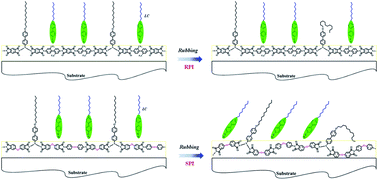Two series of polyimides (PIs) which contained identical side chains but different backbones were synthesized from the same functional diamine: RPI-X% and SPI-X% (X = 20, 30, 40, X stands for the molar content of functional diamine). Rigid polyimides (RPIs) are PIs whose backbones are composed of wholly rigid aromatic units and soft polyimides (SPIs) are PIs whose backbones are composed of flexible ether units and aromatic units. The surface morphology, chemical composition and molecular orientation of the polyimide (PI) alignment layer surfaces were investigated by atomic force microscopy, X-ray photo-electron spectroscopy and polarized attenuated total reflection Fourier transformed infrared spectroscopy, respectively. The results showed that both RPI and SPI could induce LC to align vertically without a rubbing process when the molar content of the functional diamine reached 30%. However, the rubbed RPI-30% whose side chains were oriented vertically induced vertical alignment of the liquid crystal (LC), while the rubbed SPI-30% whose side chains were oriented parallel induced parallel alignment of the LC. The cause of this distinction was attributed to the different main chain structures: the wholly rigid aromatic units in RPI's main chains could restrict the movements of molecular chains so the side chains can maintain vertical orientation all the time; flexible ether bands in SPI main chains could endow molecular chains with mobility so the side chains fall over easily after rubbing.

